SON OF A An Artilleryman Follows
An Artilleryman Follows
In His Father's Footsteps
~~~~~~~~~~~~~~~~~~~~~~~~~~~~~~~
"I was standing on the back porch
as he drove away in his car," says Bob Lamkin. "And that's
the last I ever saw of him. I was six years old."
Lamkin, now 91,
is referring to his father, Robert L. Lamkin, a veteran of the Spanish-American
War (1898-99) and the Philippine Insurrection that closely followed.
The senior Lamkin served during the latter conflict, which claimed over
4,000 American lives. And then -- a quarter-century later -- he simply
disappeared.
What ties could
possibly link - much less bind -- a child to a father who suddenly abandons
his family?
"What I remember of my father is
that he fought as an artilleryman in the U.S. Army," Bob recalls.
"My only image of him is from an old photograph. He's in his uniform
standing beside a cannon."
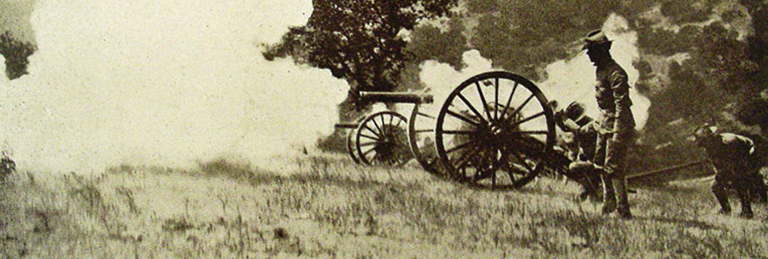
The Spanish-American War and subsequent conquest of the Philippine
islands eventually involved 126,486 U.S. troops. In this 1902
photo, a battery of 76mm Hotchkiss cannons clear the way for attacking
American infantry. Bob Lamkin's father would have helped man a
570-pound howitzer like this, pulled by a team of three mules.
|
This single connective thread, fragile though
it be, would eventually lead Lamkin to a different battlefield half a
world away. In his own time and in his own way, Lamkin managed to forge
a path that reunited him with the father he would never come to know.
But first things first. Bob Lamkin had
a few blind alleys to traverse before reaching his goal.
"I transferred to Oregon State University
as a sophomore in 1940," he explains. "ROTC was required,
and thinking back on my father I chose the field artillery (FA) rather
than the infantry or engineers." Later, Bob joined the Enlisted
Reserve Corp and remained in school until called to basic training at
Camp Roberts, California. Then off to FA officer training at Fort Sill,
Oklahoma.
|
Part way through the course, Lamkin suddenly
found himself transferred to infantry OCS at Fort Benning, Georgia.
Two weeks short of graduation, he was called before the examining
board and without explanation transferred to yet another base
in South Carolina. Surprise! Lamkin's back in artillery school.
Then as now, soldiers were apt
to use a naughty acronym - SNAFU - to describe a military mix-up.
But Bob wasn't complaining - far from it. Private Lamkin was finally
where he set out to be.
In the military, head counts are always done alphabetically. Lamkin
recalls two infantry classmates at Fort Benning by the names of
Lambert and Landis who stood either side of him at every roll
call. "They both graduated from infantry training, both were
commissioned as shave-tail lieutenants, and both died a few days
apart during the Battle of the Bulge. So you could say the board
did me a favor."
Following graduation, Lamkin's class
assembled at Boston harbor where it boarded a converted banana
boat, bound for Europe. Skipping a stopover in Britain, the ship
crossed the English channel and off-loaded on the French coast.
"We gathered up our guns and ammo and towing vehicles and
went a short ways inland to a chateau, where we hunkered
|
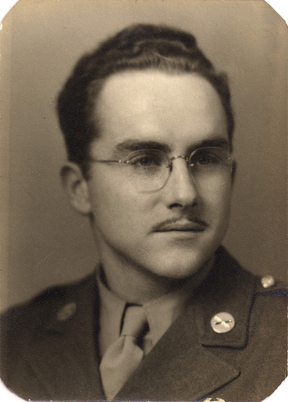 PFC Robert L. Lamkin
PFC Robert L. Lamkin
|
down. The chateau had been a Wehrmacht headquarters,
until our infantry chased them out. I think it was around the end of June,
almost a month after D-day." Bob also notes that chateau living was
a welcome surprise; Normandy had yet to fall and the battle of the hedgerows
kept dragging on. With each passing summer day, the din of battle gradually
faded as the Allies gained a solid foothold in southern France.
And then George S. Patton arrived on the scene…
Bob's battalion served under the Third Army, commanded by General Patton.
Says Lamkin: "He was always in a rush to get there first. When
Patton took off, he went like a raped ape and woe betide those who couldn't
keep up. I remember reading a story in Stars and Stripes that quoted
him as saying 'I'm going to cross the Rhine if I have to send home a
boat-load of dog tags.' That didn't sit too well with the troops, as
you might imagine."
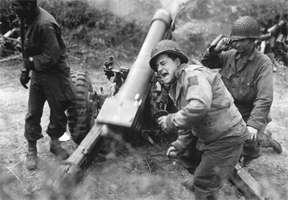 |
These two iconic images leave little to be imagined.
A U.S. gun crew in Normandy steels itself against the sound and
fury of a fired 105mm cannon, while the sole surviving crew member
of a German 88mm ponders his fate in the aftermath of a losing
artillery duel with Russian tanks.
|
Photos
enlarge when clicked)
|
|
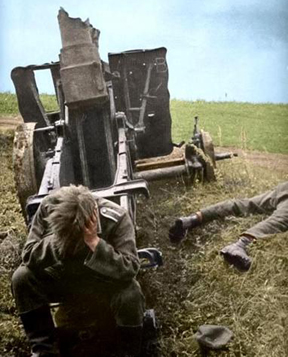 |
Lamkin was assigned to headquarters battery,
the command staff for the entire battalion. Each FA battalion consisted
of three batteries (A, B and C), totaling in all 12 guns and a complement
of support troops. Thus, a typical infantry division was backed up by
fifty-four 105mm howitzers, the workhorse cannon of WW11. Experienced
artillerymen in a race against the clock to engage the enemy prided themselves
in executing given commands in the shortest possible time span. Bob Lamkin
was witness to just such a performance the first time out of the bullpen
- and likely owes his very life to a set of skills perfectly planned and
promptly executed.
|

Bob Lamkin feeds the open belly of a 105-mm howitzer during the
battle of the Ardennes, while the gun captain stands ready at
the right -- paused to pull the firing lanyard the moment the
breech is closed.
|
"Our
battalion and a number of others began moving inland, until we finally
ended up in Belgium just behind the front line in an area adjacent
to where the Battle of the Bulge was going on. We had just unhooked
all twelve guns from the towing tractors.
"Without warning, a salvo
of artillery shells descended at our rear, maybe a hundred feet
away. The terrain ahead was sloped, with the hilltop facing us,
and the firing was coming from somewhere out of sight beyond the
crest," Lamkin recalls. A lethal concoction of dirt, smoke
and flying shrapnel sent Lamkin scampering for the nearest sanctuary
- a parked Jeep. Crawling beneath the framework and laying spread-eagle
to minimize exposure to what he knew was coming next, Bob clenched
his teeth and tightened his sphincter muscles. A second salvo
of equal force arrived moments later, this time exploding in front
of the battery. "Whoever was shooting at us likely had a
hidden forward observer ((FO) calling the shots," Lamkin
explains. Bob tried further to shrink himself in anticipation
of the grand finale --- the gunners were about to split the difference
and drop the last load right on target.
Just as suddenly, Lamkin relates,
the air overhead was rustled by the
|
|
passage of numerous artillery shells coming from various directions.
Ever alert, the headquarters command post had simultaneously contacted
no less than thirty-one other batteries scattered around a five-mile
area, and provided them with estimated co-ordinates of the enemy's
location. A blanket of destruction - well over 100 shells - saturated
the distant landscape in what is termed a TOT (time on target)
concentration. "Very lucky for us," Bob grins. "We
never did get that third salvo."
As a matter of record, artillery 'serenades'
on the battlefields of Europe occasionally reached eye-popping
proportions. In a single nighttime engagement, an attacking battalion
of German infantry was stopped in its tracks by a defensive barrage
totaling 11,500 rounds in various calibers, including 155mm. During
the Battle of the Bulge, U.S. artillery fired an estimated 1,225,000
rounds from 4,155 "tubes," as cannon barrels were labeled
by their handlers. To be sure, the infantry paid all due respect
to incoming rifle and machine gun fire. Beyond that, artillery
(and its first cousin, the mortar) were horses of another color.
Incoming artillery barrages that seemed to go on forever - thirty
minutes of continuous drum fire was not uncommon -- often left
survivors on both the Allied and Axis sides "cringing, crapping
and crying" in their foxholes - as one GI lyrically put it.
Between August 1 and November 30, 1944, Third Army medics catalogued
the following physical damage; for every gunshot
|
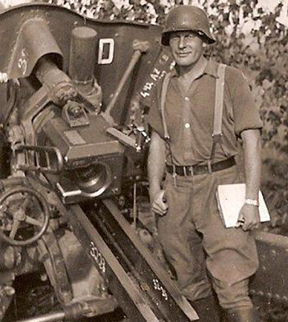 A gunner of the 4th
SS Polizei Panzer Division
tends to his firing chart: azimuths, base lines, traverse circles,
grid coordinates and a host of other calculations all affect the
degree of accuracy.
A gunner of the 4th
SS Polizei Panzer Division
tends to his firing chart: azimuths, base lines, traverse circles,
grid coordinates and a host of other calculations all affect the
degree of accuracy. |
wound, there were two explosive shrapnel
wounds. No such tally was kept of the dead.
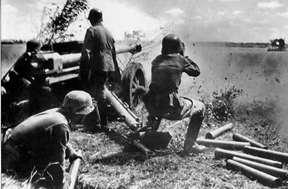 An advancing Sherman tank
falls prey to a poorly concealed 75mm PAK 40 manned by
a German crew. The
PAK 40 was capable
of penetrating 4.5 inches of armor at 500 yards.
An advancing Sherman tank
falls prey to a poorly concealed 75mm PAK 40 manned by
a German crew. The
PAK 40 was capable
of penetrating 4.5 inches of armor at 500 yards. |
Once business in the Ardennes
was attended to, the battalion was re-assigned in support of a tank
corps. Exiting Belgium into Germany in late January, 1945, Lamkin's
battery spent day after day in relentless pursuit of the retreating
Germans - further evidence of General Patton's desire to lead the
pack.* "We'd move into an area and get set up. Then the tanks
would pass through until they met enemy strong points. If that didn't
get the job done, they'd back off and we'd take a crack at it. Then
the infantry moved in." ** Not once did Lamkin's group ever
have to resort to direct fire. "That's when you shoot directly
at a visible target on the ground," he explains. "All
our distant firing at unseen targets involved a lot of computation
and co-ordination. We used high explosive (HE) shells almost exclusively.
Some exploded on contact, some we set for air-burst." Though
assigned to duties within the headquarters command staff, Lamkin
got in his fair share of licks behind the Model M2A1 |
howitzer as a breech loader
- or ammo man. What he couldn't keep track of were the number of times
his battalion picked up and moved. Like playing a continuous game
of hop-scotch and leap-frog, as Bob puts it.
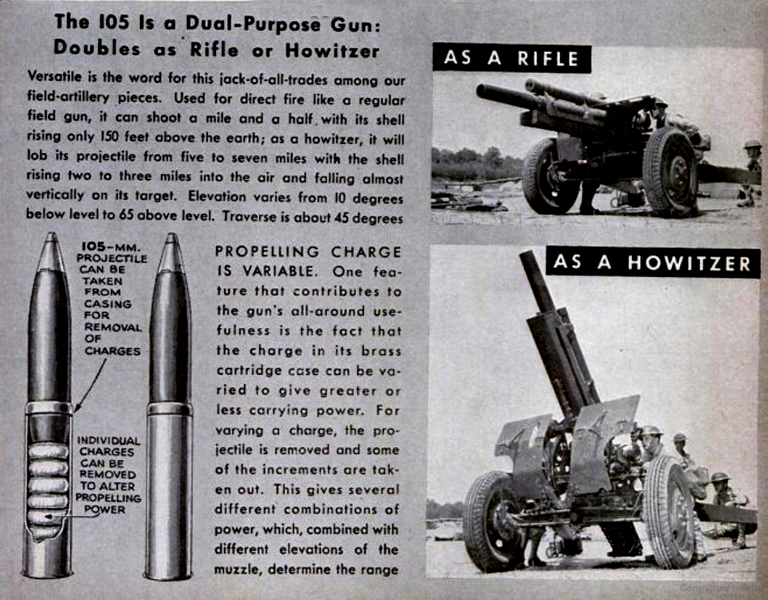
Once over the Rhine River
via a pontoon bridge, the battalion skirted Cologne and continued
cross-country into Bavaria, with stops at Schweinfurt and Frankfurt.
"We only paused if a target was assigned to us," Lamkin
notes. Unlike the front line infantry, who were obliged to dig new
foxholes most every time they moved, cannoneers enjoyed the 'luxury'
of sleeping bags spread out on the ground covered by shelter halves
- so called because two men, each joining together a canvas half shelter
-- were provided a measure of protection from the elements.
|
Lamkin's battalion wasn't exactly
on a guided European tour, though on rare occasions it seemed
that way. Next stop: Czechoslovakia - country number five. Lamkin
soon discovered there were other 'tourists' out and about, enjoying
the springtime blossoms and other amenities. "We were heading
for Vienna, Austria, when the news came down that Germany had
surrendered," Bob relates. "A few days later several
of us were checking out a small village when we came across a
farm house with some activity going on. What do we find but a
half-dozen Soviet soldiers. So we all sat around celebrating and
got kinda drunk on Russian vodka."
Fortunately, none of the men in Bob's
battery were killed, nor did they suffer any battle wounds by
war's end. Returning to Germany as part of the occupation forces,
Lamkin and half-a-dozen buddies were assigned to the 115th FA
Battalion motor pool in Frankfurt. "It was a great time for
us," he reveals. With virtually the entire German transportation
system smashed to smithereens, getting around proved a major challenge.
"In the beginning," Bob notes, "the only thing
we had to worry about was the
|
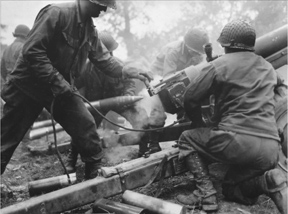 Strict rationing of a dwindling
supply of ammo from October 11 - November 7, 1944, restricted
the Third Army to twenty 105mm rounds per-gun-per-day -- in all,
76,000 shells. The subsequent drawn-out Battle of the Bulge far
exceeded that sum on any given day.
Strict rationing of a dwindling
supply of ammo from October 11 - November 7, 1944, restricted
the Third Army to twenty 105mm rounds per-gun-per-day -- in all,
76,000 shells. The subsequent drawn-out Battle of the Bulge far
exceeded that sum on any given day. |
upcoming invasion of Japan. At one point
we actually trained for that, until the Japanese surrendered in August."
The motor pool assignment, says Lamkin, proved to be a gold mine in disguise.
Senior officers and master sergeants - the ones who ruled the roost and
had the power to return favors - made heavy use of the vehicles under
Lamkin's care. The twinkle in Bob's eye suggests that a barter service
second to none flourished within the battalion.
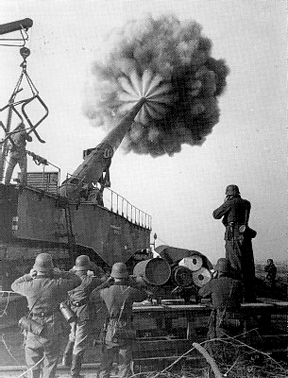 This Krupp-made K5 Tiefzug
(one of 25 manufactured) was the most successful long-range railway
gun of WW11, capable of delivering a quarter-ton shell 40 miles.
The gun's 105-foot barrel lining was rifled with twelve quarter-inch
grooves, resulting in the petal-like smoke pattern seen here.
Note all the fingers in the ears.
This Krupp-made K5 Tiefzug
(one of 25 manufactured) was the most successful long-range railway
gun of WW11, capable of delivering a quarter-ton shell 40 miles.
The gun's 105-foot barrel lining was rifled with twelve quarter-inch
grooves, resulting in the petal-like smoke pattern seen here.
Note all the fingers in the ears. |
And then
there was the irony of it all. Wars are loaded with the ironic;
scattered events have a propensity for linking up with one another.
One chance happening leads to another and - voila! To wit:
"From time to time,"
says Lamkin, "some of us were called on to help man the checkpoints
along a major roadway. We were on the lookout for certain documents
issued to returning German veterans by the occupational authorities.
If they possessed such signed and stamped documents, we let them
pass. It was their ticket back to civilian life. Those others
men who lacked such documentation were turned over to the MPs
and sent to a POW camp for further interrogation and disposition.
"One day this young man approached
the checkpoint. He looked to be in his early twenties - around
my age. He spoke perfect English, no accent. His papers -- everything
was in order. I noticed his clothes were a mix --- half military
and half civilian. We got to talking and swapping stories about
where we'd been during the war, and what our duties were. As he
got deeper into the details, it slowly became evident that this
fellow standing just a few feet away had once tried his damndest
to kill me."
A further exchange of background revealed
that the detainee's parents had immigrated to America just after
WW1 and settled in the Midwest - Iowa, to be exact. Their son
had paid relatives in Germany an extended visit just before the
war broke out - which timing proved disastrous. Despite his status
as an American citizen, he'd been drafted and assigned to an armored
regiment. In his fourth year of combat and now an
officer, he found himself fighting on the western front.
|
"He turned out to be a commander in
a Panzer brigade," Bob explains, "and it was his battle group
of Tiger and Panther tanks that attacked us with their seventy-six and
eighty-eight millimeter cannons that day in Belgium. He told me our plunging
artillery fire had destroyed or crippled nearly half his armored force."
A second chance encounter proved even more
dramatic, containing as it did all the elements of a Shakespearian tragedy.
"Not too far away there was a liberated
concentration camp," Lamkin continues, "and it was fairly common
to come across former inmates wandering around. One day this figure came
down the road, and when he saw us he turned and cut across a field. We
fired a few machine gun rounds in his direction and that got his attention.
So here's this Jewish kid, 14 years old. He told us he'd escaped twice
from the camp during the war, each time from a lineup leading to the gas
chambers. How he managed that, I can't imagine. We let him hang around
and he'd scrounge food from nearby farms."
| "One
day we were checking out this fellow whose papers appeared in order.
All decked out in civilian clothes. The kid happened to wander up
and when he saw this guy, he took off running. One of the guards
chased after the kid and brought him back. He pointed at the man
and said he was a SS major (sturmbannfuhrer) in the concentration
camp. We ordered the man to take off his shirt and there -- sure
enough -- was a SS tattoo*** under his arm.
"We decided it was the kid's
turn at bat. Somebody got a shovel, and on the sly I removed the
ammo from my carbine. We shoved the German over on the shoulder
of the road and told him to start digging. I gave my rifle to
the kid and told him he was in charge."
"So here's this SS officer
digging away. Every time he paused to catch his breath, the kid
would jab him in the arse with the rifle barrel and shout 'schnell
- schnell !' The grave was maybe two feet deep when suddenly
the guy fell to his knees, and with folded hands begged the kid
for mercy. We ordered him out of the hole and turned him over
to the MPs. Not long after we heard a solitary shot in the distance.
"And, you know… I still
wonder about that to this day"
|
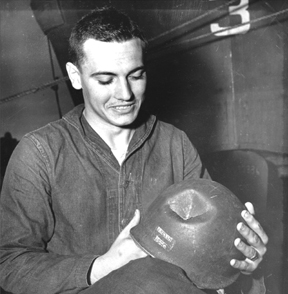 A grinning John Kelly (luck
of the Irish?) examines his helmet, battered but not penetrated
by a nearly-spent chunk of flying shrapnel. Even well dug-in infantrymen
most dreaded being caught in a heavily wooded forest; incoming
artillery rounds exploded on contact with the tree tops, driving
shrapnel into their fox holes and shelters.
A grinning John Kelly (luck
of the Irish?) examines his helmet, battered but not penetrated
by a nearly-spent chunk of flying shrapnel. Even well dug-in infantrymen
most dreaded being caught in a heavily wooded forest; incoming
artillery rounds exploded on contact with the tree tops, driving
shrapnel into their fox holes and shelters. |
##############
| |
 Lamkin and his wife of 62
years, Alma, reside in a suburb of Portland, Oregon. After finishing
college, Bob spent the majority of his working years in industrial
sales. "Most of my closest friends have passed on,"
he says. "A couple times we talked about having a reunion
in Switzerland, but somehow it never happened."
Lamkin and his wife of 62
years, Alma, reside in a suburb of Portland, Oregon. After finishing
college, Bob spent the majority of his working years in industrial
sales. "Most of my closest friends have passed on,"
he says. "A couple times we talked about having a reunion
in Switzerland, but somehow it never happened." |
|
~~~~~~~~~~~~~~~~~
* The Third Army under Patton fought
continuously for 281 days. No other army in military history ever advanced
farther and faster. Third Army killed, wounded and captured some 1,811,388
enemy combatants - six times its own strength in manpower.
** "I am the Infantry. Queen of Battle."
"I am the Artillery. King of Battle."
The King puts it where the Queen wants it.
(wall placard in the field artillery Enlisted Men's Club, Fort Sill,
OK., 1947)
*** The SS tattoo (Blutgruppentatowierung)
was worn by members of the Totenkopfverbande--SS to identify
an individual's blood type - A, B, AB or O. Application was on the underside
of the left upper arm. It served to identify blood type in case a soldier
was unconscious and in need of a transfusion.
This is another in the oral history series
by Tony Welch. See the other two at:
GATE
CRASHER VS. POTATO MASHER
THE REAL
WORLD RECORD MUSKY
About
the author

Send Corrections, additions,
and input to:
WebMaster/Editor

Click
the star for
Site Map  .. ..
|
|












